Warner Bros. is an American entertainment conglomerate founded in 1923 and especially known for its film studio. Its name originated from the four founding Warner brothers: Harry, Albert, Sam, and Jack Warner. They opened their first film studio in 1918 and formally incorporated Warner Brothers Pictures in 1923. This post concentrates on the Warner Bros. photo legacy from the 1920s to the 1960s, when Warner Bros became known for its tightly budgeted, technically competent entertainment films. Photographers who worked for the photo department of the studio include Scotty Welbourne, John Engstead and George Hurrell.
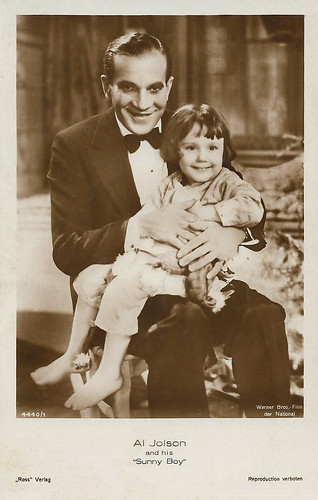
German postcard by Ross Verlag, no. 4440/1, 1929-1930. Photo: Warner Bros. Film, National. Al Jolson and his 'Sunny Boy' (Davey Lee) in the early sound film The Singing Fool (Lloyd Bacon, 1928). At the age of three, Davey Lee made his debut in one of the early talkies The Singing Fool (Lloyd Bacon, 1928). The Singing Fool remained Warner's most successful film for ten years. The theme song Sonny Boy became the first film song to sell over a million copies. Davey appeared in six films between 1928 and 1930. Then, his mother took him out of films so that he could have a normal childhood.
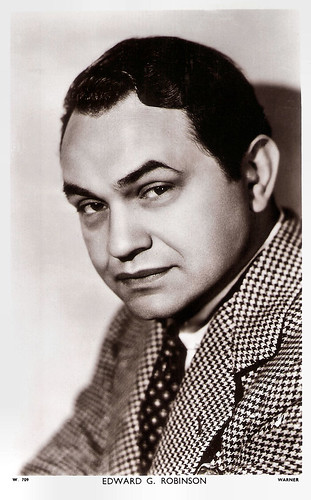
British postcard in the Picturegoer Series, London, no. W. 709. Photo: Warner. Edward G. Robinson is best remembered for his cold-eyed Machiavellian gangster roles, such as his star-making film Little Caesar (1931) as snarling, murderous thug Caesar Enrico ‘Rico’ Bandello.
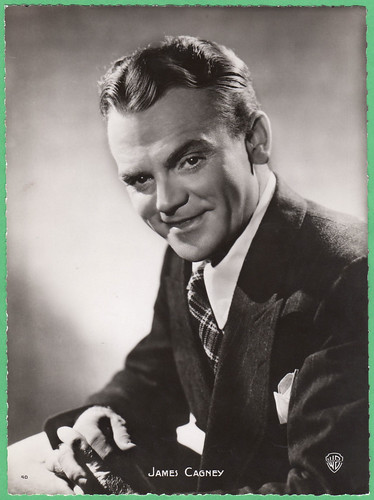
Belgian collectors card by Chocolaterie Clovis, Pepinster, no. 40. Photo: Warner Bros. Collection: Amit Benyovits. After Little Caesar, the studio's next effort was The Public Enemy. It made James Cagney arguably the studio's new top star, and Warner Bros. made more gangster films.
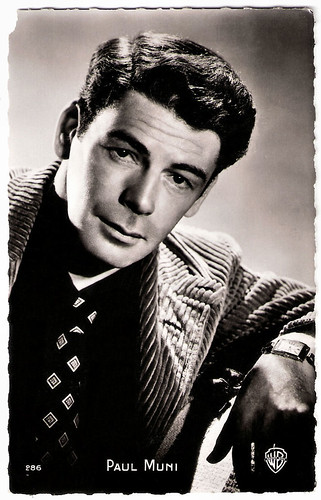
French postcard by Editions P.I., Paris, no. 286. Photo: Warner Bros. During the 1930s, Paul Muni was considered one of the most prestigious actors at the Warner Bros. studio, and was given the rare privilege of choosing which parts he wanted. His acting quality, usually playing a powerful character, such as the lead in Scarface (Howard Hawks, 1932), was partly a result of his intense preparation for his parts, often immersing himself in study of the real character's traits and mannerisms.
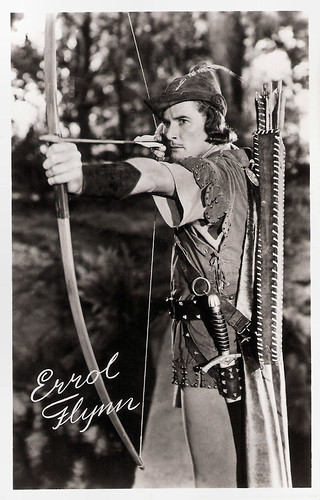
Dutch card. Photo: Warner Bros. Publicity still for The Adventures of Robin Hood (Michael Curtiz, William Keighley, 1938). Errol Flynn achieved fame in Hollywood with his suave, debonair, devil-may-care attitude. He was known for his romantic Swashbuckler roles in Warner films like Captain Blood (Michael Curtiz, 1935) and The Adventures of Robin Hood (Michael Curtiz, 1938), often co-starring with Olivia de Havilland.
Warner Bros' first important deal was the acquisition of the rights to Avery Hopwood's 1919 Broadway play, The Gold Diggers, from theatrical impresario David Belasco. However, Rin Tin Tin, a dog brought from France after World War I by an American soldier, established their reputation. Rin Tin Tin debuted in the feature Where the North Begins. The movie was so successful that Jack signed the dog to star in more films for $1,000 per week. Rin Tin Tin became the studio's top star.
In the mid-1920s, the company ran into financial difficulties. Sam Warner persuaded his brothers to collaborate in developing a patent on a process (Vitaphone) that made the 'talkies' possible, revolutionising the film industry.
In 1927, Warner Bros. made cinematic history with the release of the first film with synchronised songs and dialogue, The Jazz Singer (Alan Crosland, 1927). Thanks to the success of The Jazz Singer, the studio was cash-rich. Jolson's next film for the company, The Singing Fool (Lloyd Bacon, 1928) was also a success. With the collapse of the market for musicals, Warner Bros., under Daryl F. Zanuck, turned to more socially realistic storylines.
In the early 1930s the company started the craze for gangster films with Little Caesar (Mervyn LeRoy, 1931) with Edward G. Robinson, The Public Enemy (William A. Wellman, 1931) with James Cagney, and Scarface (Howard Hawks, 1932) with Paul Muni. For its many films about gangsters; Warner Bros. soon became known as a 'gangster studio'.
In February 1933, Warner Bros. produced 42nd Street (Lloyd Bacon, 1933), a very successful musical. Warner assigned Bacon to more expensive productions including Footlight Parade (Lloyd Bacon, 1933), Wonder Bar (Lloyd Bacon, 1934), and Gold Diggers of 1933 (Mervyn LeRoy, 1933) that saved the company from bankruptcy. In the wake of 42nd Street's success, the studio produced profitable musicals. These starred Ruby Keeler and Dick Powell and were mostly directed by Busby Berkeley.
In 1935, the revival of the musical was affected by Busby Berkeley's arrest for killing three people while driving drunk. By the end of the year, people again tired of Warner Bros. musical extravaganzas, and the studio — after the huge profits made by Captain Blood (Michael Curtiz, 1935) - shifted its focus to Errol Flynn swashbucklers and dramas featuring such stars as Bette Davis, Humphrey Bogart, and John Garfield.
Films made at Warner Bros. have been historically associated with a distinctive style. Warner films have been described as contemporary stories 'torn from today's headlines' distinguished by a cynicism and hard-bitten realism in style, tone, and technique.
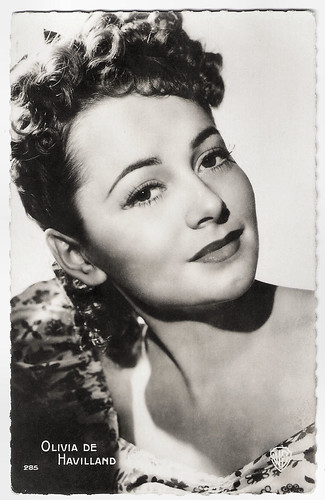
French postcard by Editions P.I., Paris, no. 285. Photo: Warner Bros. Olivia de Havilland co-starred with Errol Flynn in eight Warner films. For the classic Gone with the Wind (Victor Fleming, 1939), she received her first Oscar nomination. In 1943, de Havilland (whom Warner frequently loaned to other studios) sued Warner for breach of contract. Warner responded by sending 150 telegrams to different film production companies, warning them not to hire her for any role. Afterwards, de Havilland discovered employment contracts in California could only last seven years; de Havilland had been under contract with the studio since 1935. The court ruled in de Havilland's favour and she left the studio.
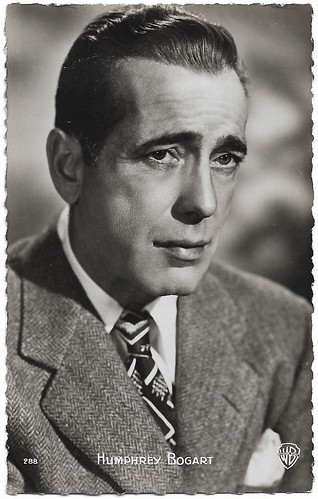
French postcard by Editions P.I., Paris, no. 288. Photo: Warner Bros. After George Raft had turned the role down, Warner Bros. gave Humphrey Bogart the role of 'Mad Dog' Roy Earle in High Sierra (Raoul Walsh, 1941), which helped establish him as a top star. Following High Sierra and after Raft had once again turned the part down, Bogart was given the leading role in John Huston's successful 1941 remake of the studio's 1931 pre-Code film, The Maltese Falcon, based upon the Dashiell Hammett novel. Bogart's star continued to ascend with the Howard Hawks-directed Film Noir masterwork The Big Sleep (1946), and two consummate Huston films, The Treasure of the Sierra Madre (1948) and Key Largo (1948).
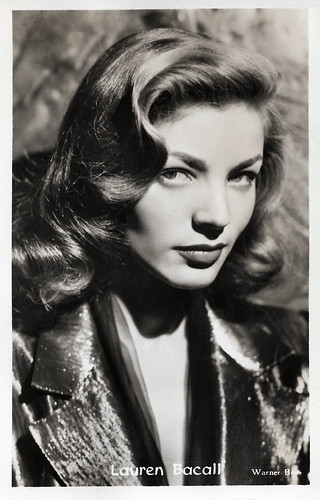
Dutch postcard. Photo: Warner Bros. Publicity still for The Big Sleep (Howard Hawks, 1946). Lauren Bacall became an overnight star as 'Slim' opposite Humphrey Bogart in her memorable film debut in To Have and Have Not (Howard Hawks, 1942). She became known for her distinctive husky voice and glamorous looks in Film Noirs as The Big Sleep (Howard Hawks, 1946), Dark Passage (Delmer Daves, 1947), and Key Largo (John Huston, 1948).
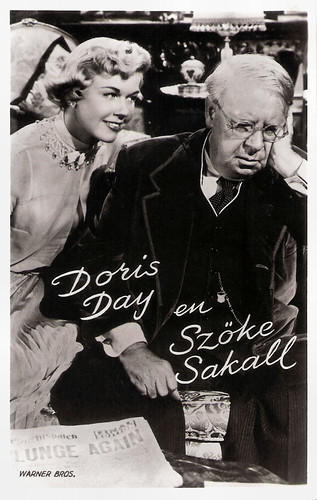
Dutch postcard by Takken / 't Sticht, no. AX 343. Photo: Warner Bros. Publicity still for Tea for Two (David Butler, 1950) with Doris Day and Szöke Szakáll. Tea for Two was the first film for which Day received top-billing. Many popular musicals and a string of romantic comedies with Rock Hudson would follow.
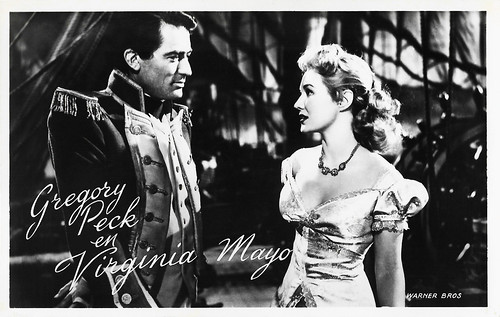
Dutch postcard by Takken, Utrecht, no. 610. Photo: Warner Bros. Publicity still for Captain Horatio Hornblower (Raoul Walsh, 1951) with Gregory Peck and Virginia Mayo. Virginia Mayo is best known for her comedies with Danny Kaye, such as The Kid from Brooklyn (Norman Z. McLeod, 1946), and The Secret Life of Walter Mitty (Norman Z. McLeod, 1947). She personified the dream girl or girl-next-door and audiences — particularly males — locked to theatres just to see her blonde hair and classic looks on-screen in Technicolor. It made Mayo Warner Brothers biggest box office money maker in the late 1940s.
Among Warner Bros.’s best-known films of the 1940s were such classics as The Maltese Falcon (John Huston, 1941) and Casablanca (Michael Curtis, 1942), both starring Humphrey Bogart. Warner Bros. produced very few top hits during the post-war era, although it did sustain its trademark Film Noirs, dark dramas, and women's pictures. Bette Davis's star was rapidly falling, but former MGM diva Joan Crawford came out of retirement to star in several Warner Bros. hits, including Mildred Pierce (1945) and Humoresque (1946).
Warner Bros. continued to create new stars, including Lauren Bacall and Doris Day. They also made such successful films as A Streetcar Named Desire (Elia Kazan, 1951) with Marlon Brando, and Rebel Without a Cause (Nicholas Ray, 1955) with James Dean.
During this period Warner Brothers also expanded into television with the premiere of the Western series Cheyenne in 1955. Cheyenne, starring Clint Walker, was television's first hour-long Western. Two episodes were placed together for feature film release outside the United States.
In the tradition of its B movies, the studio followed up with a series of rapidly produced popular Westerns, such as writer/producer Roy Huggins' critically lauded Maverick (1957–1962) with Jack Kelly, James Garner and Roger Moore, as well as Sugarfoot (1957-1961), Bronco (1958), and Lawman (1958-1962). The success of these series helped to make up for losses in the film business.
As a result, Jack Warner decided to emphasise television production. Warner's also produced a series of popular private detective shows beginning with 77 Sunset Strip (1958–1964) starring Efrem Zimbalist Jr., Edd Byrnes, and Roger Smith, followed by Hawaiian Eye (1959–1963), Bourbon Street Beat (1960) and Surfside 6 (1960–1962).
With the success of the studio's film of Broadway play My Fair Lady (George Cukor, 1964), as well as its soundtrack, Warner Bros. Records became a profitable subsidiary. The film Who's Afraid Of Virginia Woolf? (Mike Nichols, 1966) with Elizabeth Taylor and Richard Burton was a also huge success. In November 1966, Jack gave in to advancing age and changing times, selling control of the studio and music business to Seven Arts Productions.
Two years later, however, Warner was sold to the Kinney Corporation, which was headed by Steven J. Ross. He transformed Kinney into the media and entertainment empire Warner Communications, and Warner Bros., Inc., as it was renamed, became a highly diversified subsidiary, venturing into such areas as music, video games, and comic books. Despite such expansion, Warner Brothers remained focused on films and television programs. In 1990 Warner Communications merged with Time Inc. to form Time Warner Inc., the largest media and entertainment corporation in the world.
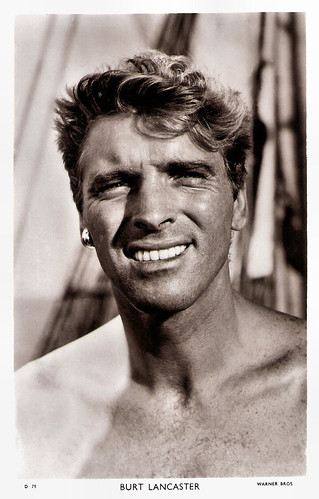
British postcard in the Picturegoer Series, no. D 79. Photo: Warner Bros. Publicity still for The Crimson Pirate (Robert Siodmak, 1952). Burt Lancaster took the lead in such popular successes as the Technicolor swashbucklers The Flame and the Arrow (Jacques Tourneur, 1950) and The Crimson Pirate (Robert Siodmak, 1952), and the Western Vera Cruz (Robert Aldrich, 1954). The films were produced by Lancaster's own company but distributed by Warner Bros.
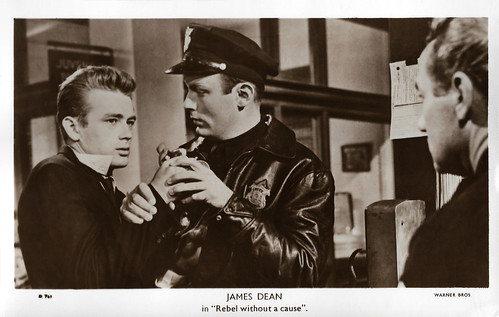
British postcard in the Picturegoer Series, London, no. D 769. Photo: Warner Bros. Publicity still for Rebel Without a Cause (Nicholas Ray, 1955). James Dean played for Warner Bros in three films that defined his stardom are as troubled teenager. He was Jim Stark in Rebel Without a Cause (1955), loner Cal Trask in East of Eden (Elia Kazan, 1955) and surly ranch hand Jett Rink in Giant (George Stevens, 1956). After his death in a car crash, the only 24-years-old Dean became the first actor to receive a posthumous Academy Award nomination for Best Actor.
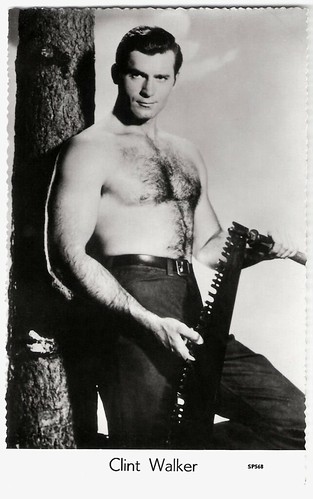
Vintage postcard, no. SP568. In the 1950s, Clint Walker with his broad shoulders and slim waist almost single-handedly started the Western craze on TV in his role as Cheyenne Bodie in Cheyenne (1955-1962). Cheyenne Bodie was a roaming cowboy hero in the post-American Civil War era. Cheyenne originally appeared as part of Warner Bros Presents rotating with adaptations of Kings Row and Casablanca. Cheyenne turned out to be the break out hit for Walker. While the series regularly capitalised on Walker's rugged frame with frequent bare-chested scenes, it was also well written and acted. It proved hugely popular for eight seasons. Walker's pleasant baritone singing voice was also occasionally utilised on the series and led Warner Brothers to produce an album of Walker doing traditional songs and ballads.
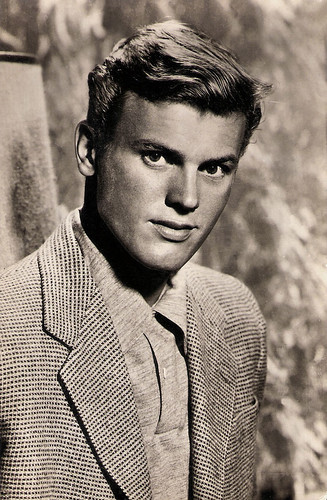
Spanish postcard by Archivo Bermejo, no. 5495. Photo: Warner Bros. Publicity still for Lafayette Escadrille (William A Wellman, 1958). With his blond, tanned, surfer-boy good looks, Tab Hunter was one of Hollywood’s hottest teen idols of the 1950s era. The American actor, singer, and author portrayed boy-next-door marines, cowboys and swoon-bait sweethearts, and had a huge hit with the song Young Love (1957). In 1958, the studio launched Warner Bros. Records.
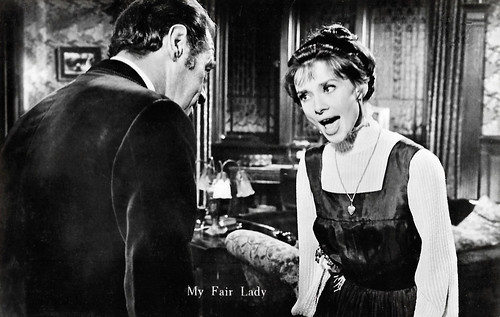
Dutch postcard by Int. Filmpers, Amsterdam, no. 1306. Photo: Warner Bros. Rex Harrison and Audrey Hepburn in My Fair Lady (George Cukor, 1964).
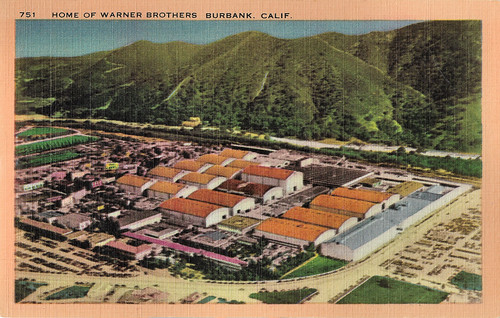
American postcard by Longshaw Card Co., Los Angles, Calif., no. 751. Caption: "The Motion Picture Industry is one of the first four industrries in the United States. More than 70% of the pictures shown throughout the world are produced in Los Angeles County."
Sources: Encyclopedia Britanica, Film Reference, and Wikipedia.

German postcard by Ross Verlag, no. 4440/1, 1929-1930. Photo: Warner Bros. Film, National. Al Jolson and his 'Sunny Boy' (Davey Lee) in the early sound film The Singing Fool (Lloyd Bacon, 1928). At the age of three, Davey Lee made his debut in one of the early talkies The Singing Fool (Lloyd Bacon, 1928). The Singing Fool remained Warner's most successful film for ten years. The theme song Sonny Boy became the first film song to sell over a million copies. Davey appeared in six films between 1928 and 1930. Then, his mother took him out of films so that he could have a normal childhood.

British postcard in the Picturegoer Series, London, no. W. 709. Photo: Warner. Edward G. Robinson is best remembered for his cold-eyed Machiavellian gangster roles, such as his star-making film Little Caesar (1931) as snarling, murderous thug Caesar Enrico ‘Rico’ Bandello.

Belgian collectors card by Chocolaterie Clovis, Pepinster, no. 40. Photo: Warner Bros. Collection: Amit Benyovits. After Little Caesar, the studio's next effort was The Public Enemy. It made James Cagney arguably the studio's new top star, and Warner Bros. made more gangster films.

French postcard by Editions P.I., Paris, no. 286. Photo: Warner Bros. During the 1930s, Paul Muni was considered one of the most prestigious actors at the Warner Bros. studio, and was given the rare privilege of choosing which parts he wanted. His acting quality, usually playing a powerful character, such as the lead in Scarface (Howard Hawks, 1932), was partly a result of his intense preparation for his parts, often immersing himself in study of the real character's traits and mannerisms.

Dutch card. Photo: Warner Bros. Publicity still for The Adventures of Robin Hood (Michael Curtiz, William Keighley, 1938). Errol Flynn achieved fame in Hollywood with his suave, debonair, devil-may-care attitude. He was known for his romantic Swashbuckler roles in Warner films like Captain Blood (Michael Curtiz, 1935) and The Adventures of Robin Hood (Michael Curtiz, 1938), often co-starring with Olivia de Havilland.
Torn from today's headlines
Warner Bros' first important deal was the acquisition of the rights to Avery Hopwood's 1919 Broadway play, The Gold Diggers, from theatrical impresario David Belasco. However, Rin Tin Tin, a dog brought from France after World War I by an American soldier, established their reputation. Rin Tin Tin debuted in the feature Where the North Begins. The movie was so successful that Jack signed the dog to star in more films for $1,000 per week. Rin Tin Tin became the studio's top star.
In the mid-1920s, the company ran into financial difficulties. Sam Warner persuaded his brothers to collaborate in developing a patent on a process (Vitaphone) that made the 'talkies' possible, revolutionising the film industry.
In 1927, Warner Bros. made cinematic history with the release of the first film with synchronised songs and dialogue, The Jazz Singer (Alan Crosland, 1927). Thanks to the success of The Jazz Singer, the studio was cash-rich. Jolson's next film for the company, The Singing Fool (Lloyd Bacon, 1928) was also a success. With the collapse of the market for musicals, Warner Bros., under Daryl F. Zanuck, turned to more socially realistic storylines.
In the early 1930s the company started the craze for gangster films with Little Caesar (Mervyn LeRoy, 1931) with Edward G. Robinson, The Public Enemy (William A. Wellman, 1931) with James Cagney, and Scarface (Howard Hawks, 1932) with Paul Muni. For its many films about gangsters; Warner Bros. soon became known as a 'gangster studio'.
In February 1933, Warner Bros. produced 42nd Street (Lloyd Bacon, 1933), a very successful musical. Warner assigned Bacon to more expensive productions including Footlight Parade (Lloyd Bacon, 1933), Wonder Bar (Lloyd Bacon, 1934), and Gold Diggers of 1933 (Mervyn LeRoy, 1933) that saved the company from bankruptcy. In the wake of 42nd Street's success, the studio produced profitable musicals. These starred Ruby Keeler and Dick Powell and were mostly directed by Busby Berkeley.
In 1935, the revival of the musical was affected by Busby Berkeley's arrest for killing three people while driving drunk. By the end of the year, people again tired of Warner Bros. musical extravaganzas, and the studio — after the huge profits made by Captain Blood (Michael Curtiz, 1935) - shifted its focus to Errol Flynn swashbucklers and dramas featuring such stars as Bette Davis, Humphrey Bogart, and John Garfield.
Films made at Warner Bros. have been historically associated with a distinctive style. Warner films have been described as contemporary stories 'torn from today's headlines' distinguished by a cynicism and hard-bitten realism in style, tone, and technique.

French postcard by Editions P.I., Paris, no. 285. Photo: Warner Bros. Olivia de Havilland co-starred with Errol Flynn in eight Warner films. For the classic Gone with the Wind (Victor Fleming, 1939), she received her first Oscar nomination. In 1943, de Havilland (whom Warner frequently loaned to other studios) sued Warner for breach of contract. Warner responded by sending 150 telegrams to different film production companies, warning them not to hire her for any role. Afterwards, de Havilland discovered employment contracts in California could only last seven years; de Havilland had been under contract with the studio since 1935. The court ruled in de Havilland's favour and she left the studio.

French postcard by Editions P.I., Paris, no. 288. Photo: Warner Bros. After George Raft had turned the role down, Warner Bros. gave Humphrey Bogart the role of 'Mad Dog' Roy Earle in High Sierra (Raoul Walsh, 1941), which helped establish him as a top star. Following High Sierra and after Raft had once again turned the part down, Bogart was given the leading role in John Huston's successful 1941 remake of the studio's 1931 pre-Code film, The Maltese Falcon, based upon the Dashiell Hammett novel. Bogart's star continued to ascend with the Howard Hawks-directed Film Noir masterwork The Big Sleep (1946), and two consummate Huston films, The Treasure of the Sierra Madre (1948) and Key Largo (1948).

Dutch postcard. Photo: Warner Bros. Publicity still for The Big Sleep (Howard Hawks, 1946). Lauren Bacall became an overnight star as 'Slim' opposite Humphrey Bogart in her memorable film debut in To Have and Have Not (Howard Hawks, 1942). She became known for her distinctive husky voice and glamorous looks in Film Noirs as The Big Sleep (Howard Hawks, 1946), Dark Passage (Delmer Daves, 1947), and Key Largo (John Huston, 1948).

Dutch postcard by Takken / 't Sticht, no. AX 343. Photo: Warner Bros. Publicity still for Tea for Two (David Butler, 1950) with Doris Day and Szöke Szakáll. Tea for Two was the first film for which Day received top-billing. Many popular musicals and a string of romantic comedies with Rock Hudson would follow.

Dutch postcard by Takken, Utrecht, no. 610. Photo: Warner Bros. Publicity still for Captain Horatio Hornblower (Raoul Walsh, 1951) with Gregory Peck and Virginia Mayo. Virginia Mayo is best known for her comedies with Danny Kaye, such as The Kid from Brooklyn (Norman Z. McLeod, 1946), and The Secret Life of Walter Mitty (Norman Z. McLeod, 1947). She personified the dream girl or girl-next-door and audiences — particularly males — locked to theatres just to see her blonde hair and classic looks on-screen in Technicolor. It made Mayo Warner Brothers biggest box office money maker in the late 1940s.
Sustaining its trademark Film Noirs, dark dramas, and women's pictures
Among Warner Bros.’s best-known films of the 1940s were such classics as The Maltese Falcon (John Huston, 1941) and Casablanca (Michael Curtis, 1942), both starring Humphrey Bogart. Warner Bros. produced very few top hits during the post-war era, although it did sustain its trademark Film Noirs, dark dramas, and women's pictures. Bette Davis's star was rapidly falling, but former MGM diva Joan Crawford came out of retirement to star in several Warner Bros. hits, including Mildred Pierce (1945) and Humoresque (1946).
Warner Bros. continued to create new stars, including Lauren Bacall and Doris Day. They also made such successful films as A Streetcar Named Desire (Elia Kazan, 1951) with Marlon Brando, and Rebel Without a Cause (Nicholas Ray, 1955) with James Dean.
During this period Warner Brothers also expanded into television with the premiere of the Western series Cheyenne in 1955. Cheyenne, starring Clint Walker, was television's first hour-long Western. Two episodes were placed together for feature film release outside the United States.
In the tradition of its B movies, the studio followed up with a series of rapidly produced popular Westerns, such as writer/producer Roy Huggins' critically lauded Maverick (1957–1962) with Jack Kelly, James Garner and Roger Moore, as well as Sugarfoot (1957-1961), Bronco (1958), and Lawman (1958-1962). The success of these series helped to make up for losses in the film business.
As a result, Jack Warner decided to emphasise television production. Warner's also produced a series of popular private detective shows beginning with 77 Sunset Strip (1958–1964) starring Efrem Zimbalist Jr., Edd Byrnes, and Roger Smith, followed by Hawaiian Eye (1959–1963), Bourbon Street Beat (1960) and Surfside 6 (1960–1962).
With the success of the studio's film of Broadway play My Fair Lady (George Cukor, 1964), as well as its soundtrack, Warner Bros. Records became a profitable subsidiary. The film Who's Afraid Of Virginia Woolf? (Mike Nichols, 1966) with Elizabeth Taylor and Richard Burton was a also huge success. In November 1966, Jack gave in to advancing age and changing times, selling control of the studio and music business to Seven Arts Productions.
Two years later, however, Warner was sold to the Kinney Corporation, which was headed by Steven J. Ross. He transformed Kinney into the media and entertainment empire Warner Communications, and Warner Bros., Inc., as it was renamed, became a highly diversified subsidiary, venturing into such areas as music, video games, and comic books. Despite such expansion, Warner Brothers remained focused on films and television programs. In 1990 Warner Communications merged with Time Inc. to form Time Warner Inc., the largest media and entertainment corporation in the world.

British postcard in the Picturegoer Series, no. D 79. Photo: Warner Bros. Publicity still for The Crimson Pirate (Robert Siodmak, 1952). Burt Lancaster took the lead in such popular successes as the Technicolor swashbucklers The Flame and the Arrow (Jacques Tourneur, 1950) and The Crimson Pirate (Robert Siodmak, 1952), and the Western Vera Cruz (Robert Aldrich, 1954). The films were produced by Lancaster's own company but distributed by Warner Bros.

British postcard in the Picturegoer Series, London, no. D 769. Photo: Warner Bros. Publicity still for Rebel Without a Cause (Nicholas Ray, 1955). James Dean played for Warner Bros in three films that defined his stardom are as troubled teenager. He was Jim Stark in Rebel Without a Cause (1955), loner Cal Trask in East of Eden (Elia Kazan, 1955) and surly ranch hand Jett Rink in Giant (George Stevens, 1956). After his death in a car crash, the only 24-years-old Dean became the first actor to receive a posthumous Academy Award nomination for Best Actor.

Vintage postcard, no. SP568. In the 1950s, Clint Walker with his broad shoulders and slim waist almost single-handedly started the Western craze on TV in his role as Cheyenne Bodie in Cheyenne (1955-1962). Cheyenne Bodie was a roaming cowboy hero in the post-American Civil War era. Cheyenne originally appeared as part of Warner Bros Presents rotating with adaptations of Kings Row and Casablanca. Cheyenne turned out to be the break out hit for Walker. While the series regularly capitalised on Walker's rugged frame with frequent bare-chested scenes, it was also well written and acted. It proved hugely popular for eight seasons. Walker's pleasant baritone singing voice was also occasionally utilised on the series and led Warner Brothers to produce an album of Walker doing traditional songs and ballads.

Spanish postcard by Archivo Bermejo, no. 5495. Photo: Warner Bros. Publicity still for Lafayette Escadrille (William A Wellman, 1958). With his blond, tanned, surfer-boy good looks, Tab Hunter was one of Hollywood’s hottest teen idols of the 1950s era. The American actor, singer, and author portrayed boy-next-door marines, cowboys and swoon-bait sweethearts, and had a huge hit with the song Young Love (1957). In 1958, the studio launched Warner Bros. Records.

Dutch postcard by Int. Filmpers, Amsterdam, no. 1306. Photo: Warner Bros. Rex Harrison and Audrey Hepburn in My Fair Lady (George Cukor, 1964).

American postcard by Longshaw Card Co., Los Angles, Calif., no. 751. Caption: "The Motion Picture Industry is one of the first four industrries in the United States. More than 70% of the pictures shown throughout the world are produced in Los Angeles County."
Sources: Encyclopedia Britanica, Film Reference, and Wikipedia.
No comments:
Post a Comment